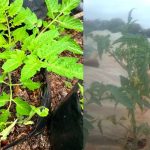To keep weeds out of a wildflower garden, regularly weed by hand and apply mulch to suppress weed growth. A well-maintained wildflower garden requires consistent manual weeding. And the use of organic mulch to prevent weed seeds from sprouting and competing with wildflowers for nutrients and space. Additionally, tilling, loosening of soil, and use of herbicides is an alternative option.
Generally, the weeds can sprout in less than 5-7 days. Some weeds like cannabis can be grown for only 2 days in favorable conditions. So keeping weed is a daunting task and it requires repetitive work.
Why is It Important To Weed Control In Wildflower Gardens?
Weed control is crucial for the health and beauty of wildflower gardens.
Weeds negatively impact wildflower growth and biodiversity. They compete with wildflowers for essential resources.
Removing weeds helps to maintain the aesthetics and longevity of your wildflower garden.
Proper weed control allows wildflowers to fully access sunlight, water, and nutrients.
This fosters their growth and ensures their survival amidst weed competition.
Regular weeding also prevents the spread of invasive plant species that can disrupt the delicate ecosystem of a wildflower garden.
Furthermore, both weeds and wildflowers may seem to be companions to grow. But if your primary purpose is to grow the wildflower then weed management is necessary.

Essential Techniques For Preventing Weed Infestation
As an Agriculturist, I know lots of methods to prevent weed infestation. However, not every method is appropriate for each garden.
Again, the cultural practice will depend on the types of weeds infested around the area.
But I can share some ideas for Preventing Weed Infestation. Here-
Right Location
One effective technique for keeping weeds out of a wildflower garden is to choose the right location.
Suppose you’re planting the wildflower in a place where you go within a week or even not. Such a place isn’t perfect for wildflower cultivation.
But you can do that, Just be sure to look after it week after week.
Soil Preparation Techniques
Another important step is to properly prepare the soil to minimize weed growth.
In addition, selecting the appropriate wildflower species can help discourage weed growth.
You will need to select the soil that is weed-free.
The use of herbicide is a fruitful option to deteriorate weeds.
Glyphosate, a non-selective herbicide will be a good option to use. It will prevent weed infestation like killing stolon, rhizomes, etc.
Mulch Preparation
Applying mulch to the garden can also eliminate weed germination and growth.
Generally, I prefer organic mulch (Straw, bark chips, wood straw, or compost). These serve as mulch along with nutrients to the plants.
However, mulch can reduce weeds by about 45 to 85 percent.
Thicker, coarser organic mulch works better than finer mulch like compost.
Bark mulch can reduce weed growth by as much as 90%
| Mulch Type | Benefits | Weed Suppression Mechanism | Others |
|---|---|---|---|
| Bark Mulch | – Blocks sunlight – Natural appearance | – Deprives weed seeds of necessary sunlight for germination | – Adds nutrients to soil |
| Inorganic Mulch | – Retains moisture – Durable | – Prevents weed growth | – Doesn’t degrade easily |
| Wood Chips | – Blocks light | – Inhibits weed growth | – Layer of 2 to 3 inches |
| Straw and Hay | – Provides annual weed control | – Forms a barrier that restricts weed emergence | – Adds nutrients to the soil |
Tillage
Tillage is an easy process to maintain weed vegetation in your garden. The repetition of tillage is effective in every 2-3 weeks interval.
In that way, the weeds hardly germinate and keep the field clean. But don’t miss the next tillage after the first operations.
Controlling perennial weed species is more effective with tillage operation. Some commonly perennial weeds are-
- Dandelion
- Purslane
- Common Nettle
- Canada thistle
- White goosefoot
- Quackgrass
- Common Dandelion
- Ground-ivy
However, if you want to avoid using herbicides, this method is perfect. Although you will need to hard work to till the whole land.
Especially, if you own a small land this organic method is easy to use.
Also Read: How to Clear an Overgrown Garden Fast? ( Answered )
Use of Herbicides
According to Applewood Seed Company, a non-selective, non-residual herbicide such as a glyphosate product can be applied during site preparation to remove existing weeds and unwanted vegetation.
After site preparation, a soil fumigant that kills weed seeds may be used for additional weed control.
If aggressive, perennial weeds such as bindweed are present, using an herbicide is more effective than tilling.
Irrigate to encourage germination of weed seeds near the surface; most seeds will germinate within two weeks if consistent moisture is available.
Do not till the soil again because this will bring even more weed seeds up to the surface.
Spray any new growth with glyphosate herbicide.

Effective Weed Management Strategies For Wildflower Gardens
Weed management in wildflower gardens requires regular hand weeding and manual removal techniques. Additionally, implementing weed barrier fabrics and landscape fabrics can help prevent weed growth.
Weed barrier fabrics, also known as weed control fabrics or landscape fabrics, are materials designed to prevent the growth of weeds in gardens, flower beds, and other landscaped areas.
These fabrics are typically made from woven or non-woven synthetic materials like polypropylene or polyester. They come in various thicknesses and strengths to suit different gardening needs.
Hand-held clippers an also an effective way to minimize the weed population in the garden.
You will able to selectively cut the weeds that you want.
Another option is Allelopathy.
Alright, so imagine you’ve got this wildflower garden you’re really proud of. You want those gorgeous blooms to shine, but those pesky weeds keep trying to steal the spotlight.
That’s where allelopathy comes into play – it’s like nature’s way of saying, “Hey, I’ve got a secret weapon against those weeds!”
Allelopathy is basically when certain plants release chemicals into the environment that affect other nearby plants. These chemicals are called allelochemicals, and they can be either good or bad news for your garden.
When it comes to managing weeds, allelopathy can be a real game-changer. Some related weeds are-
- Pigweed
- Bermudagrass (Cynodon dactylon)
- Johnsongrass (Sorghum halepnese)
- Purple nutsedge, etc
So, whether clean your wildflower garden keep these strategies in mind.
How Do You Kill Weeds Without Killing Wildflowers?
In captivity, there’s a risk when you perform such a task along with wildflowers and weeds.
Although it’s possible to kill weeds without killing wildflowers.
Generally, in a wildflower garden, some possible species are-
| Wildflower Species | Characteristics |
|---|---|
| Black-Eyed Susan | Vibrant yellow flowers with dark centers; attract bees, butterflies |
| California Poppy | Delicate orange blossoms; adaptable to various climates |
| Purple Coneflower | Pink-purple petals with cone-shaped centers; support pollinators |
| Coreopsis | Daisy-like flowers in various colors; hardy with extended blooms |
| Lupine | Tall spikes of blue, purple, or pink; fix nitrogen in the soil |
| Blanketflower | Tubular flowers, and fragrant leaves; lure hummingbirds and bees |
| Bee Balm | Tubular flowers, fragrant leaves; lure hummingbirds and bees |
| Indian Blanket | Red and yellow flowers resembling Native American pattern |
| Wild Bergamot | Pinkish-purple blossoms with fragrance; popular among pollinators |
| Blue Flax | Delicate blue flowers on slender stems; attract butterflies |
You can grow above species without any doubt. Every species has unique characteristics.
First, you have to select and identify the types of weeds that take place in your garden. Some weeds species are –
- Dandelion
- Crabgrass
- Common Chickweed
- Broadleaf Plantain
- Creeping Charlie
- Canada Thistle
- Bindweed
Now, after getting the specific weed species, you should focus on targeted herbicides.
- For Dandelion and Bindweed, the 2,4-D, mecoprop, and dicamba is the accurate choice to destroy its population.
- On the other side, crabgrass is a commonly found weed species in wildflower gardens. To eradicate these species use of Quinclorac (Drive XLR8, Quinclorac 75DF) is the fruitful way.
- However, to control the population of Broadleaf Plantain, the use of mesotrione (Tenacity) herbicide is good.
- The broad use of glyphosate fungicide is an all-time preferable option for all weed species.
These are some ideas and herbicide names that you can use as per criteria. Considering all the factors of your garden, you can take the necessary initiative or go for a professional if your garden is too big to maintain.
Otherwise, excess use of fungicides can contaminate the environment and well water in your garden.
Some Advice:
- Try to avoid spraying the herbicide directly on the wildflowers.
- Consider using organic weed control methods, such as hand-pulling or smothering the weeds with mulch.
- Regularly monitor the area for weed growth and promptly remove any invaders.
- Create a healthy environment for wildflowers by improving soil quality and providing adequate sunlight and water.
- Encourage the growth of desirable plants by using native plants and applying appropriate fertilizers.
- Be patient and persistent in your weed control efforts to maintain a weed-free environment without compromising the well-being of wildflowers.

How Do You Control Weeds In Wildflowers?
In a simple way, you can control weeds by preparing the soil and removing the existing weeds. To do that, you can cover the soil with mulch ( paper, cardboard, or black polyethylene ).
Then cover up with a layer of 1/2 ich of wood dust, compost, or straw. It inhibits the weed seed from coming into contact with light and finally won’t germinate.
After doing these, regularly check up if any weeds are emerging. If does then manually remove that.
In cases of persistent or extensive weed infestations, you may need to use a selective herbicide specifically labeled for use with wildflowers.
However, maintaining a healthy and dense wildflower planting will help to naturally suppress weed growth.
Regularly watering and fertilizing the wildflowers can aid in their competitiveness against weeds.
And finally, make sure to remove any weed seeds or plant debris to prevent future weed growth.
Will Wildflowers Grow Over Weeds?
Yes, wildflowers can grow over weeds.
They can compete with weeds for space, light, and nutrients. Wildflowers are typically resilient and can thrive in various conditions.
They can establish themselves even in areas with existing weed growth.
By planting wildflowers, you can encourage their growth and help suppress weed growth in your garden or landscape.
Remember to prepare the soil properly and remove any large weeds before planting the wildflowers.
It is also important to select the right mix of wildflower species that are well-suited to your specific climate and soil conditions.
As an example-
- BlackEyed Susan– Wide range of climates; adaptable to various conditions
- California Poppy– Mediterranean and mild climates; well-drained soil
- Lupine – Well temperate to cool climates
- Bee Balm -Temperate to subtropical climates; moist soil
- Indian Blanket– Warm and dry climates; well-drained soil
- Blue Flax– Dry to temperate climates; well-drained soil
With proper care and maintenance, wildflowers can outcompete weeds and create a beautiful and vibrant natural setting.
What Will Kill Weeds But Not Flowers?
In my opinion, The best way to kill weeds without harming flowers is by using selective herbicides.
These herbicides target specific types of weeds while leaving the flowers untouched.
Selective herbicides contain active ingredients like 2,4-D, dicamba, or clopyralid, which target broadleaf weeds, but have little to no effect on flowering plants.
Before using any herbicide, it’s crucial to know about its mode of action and effectiveness on weeds. So be sure to use herbicide in a wildflower garden as per weed species.
By the way, try to use the herbicide directly to the weed’s foliage, avoiding contact with the flowers.
Take care not to overspray or allow the herbicide to drift onto desired plants. You can cover up the wildflower and then spray it.
It is also recommended to apply herbicides on calm days with no wind.
To further prevent damage to flowers, apply mulch around the base of your plants.
This will help smother weed growth and reduce the need for herbicides.
Timely hand-pulling of weeds, and maintaining healthy soil conditions can also contribute to preventing weed infestations.
Conclusion
To sum up, I can assume that, If your garden is over-infested with weeds, then the use of herbicide is a good option. Although I am against the chemical option. But it is the best possible way.
Try to adopt the organic mulching system, and flower covering during the use of herbicide, soil treatment, etc.
By following the tips shared in this blog post, you can effectively keep weeds out of your wildflower garden.
Along with that, pulling weeds by hand and applying mulch, will prevent weed growth and protect the health of your wildflowers.
Try to remove weeds before they have a chance to spread their seeds, ensuring that they don’t return.
Utilizing organic weed control methods, such as vinegar and boiling water, can also be effective in eliminating weeds without harming your wildflowers or the environment.
Thanks
Reference:https://www.denbow.com/bark-mulch-ultimate-weed-suppressant/
http://horttech.ashspublications.org/content/17/2/174.full

I am a graduate of Bangladesh Agricultural University, where I delved into various agricultural disciplines, equipping me with a profound understanding of agriculture. Beyond academics, I have hands-on experience in gardening and crop cultivation. My passion is to embrace sustainable farming and horticulture. With a BSc in Agriculture, I am dedicated to promoting environmentally conscious and efficient agrarian practices.
Bachelor of Science (BSc) in Agriculture (Hons.)
Master of Science. (Sustainable Agriculture & Food Security ) (MS)
Bangladesh Agricultural University




